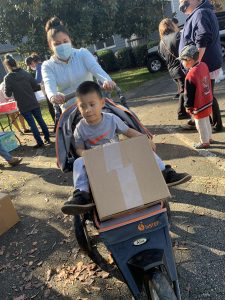By Jean Blish Siers *
I have always had anxiety dreams: As a kid, I constantly dreamt that I headed to the first day of school in my pajamas with no idea where my classes were. Even now, my dreams are usually the grown up version of that: I’m at the airport with no ticket (for young people, we used to have a thing called a “ticket” to get on the plane), or I’m in a hotel room in a foreign city with no luggage.
The other night I had a new one: I’m in a grocery store and can’t find what I need, which means I spend more time inside (where I’m not particularly comfortable these days.) Then I realize I’m the only one masked. And they are crowding around me. In my dream, nothing I did could get me out of the loop of long aisles and unsafe shoppers. I woke in a panic!
It got me thinking about all the people struggling to put food on the table during this pandemic. For them, a trip to the grocery store has to feel like an anxiety dream, but they never get to wake up.
 Food insecurity (defined as not being able to provide enough nutritious food for everyone in the household for every meal) has skyrocketed since March, when shutdowns dramatically cut people’s incomes, and many children who normally ate breakfast and lunch in school were suddenly home and hungry.
Food insecurity (defined as not being able to provide enough nutritious food for everyone in the household for every meal) has skyrocketed since March, when shutdowns dramatically cut people’s incomes, and many children who normally ate breakfast and lunch in school were suddenly home and hungry.
A study by the Institute for Public Research reports food insecurity by week. The numbers are stark. In my home state of North Carolina, for instance, 34.6% of families with children currently report food insecurity, and for Black and Hispanic families, those numbers are 47.9% and 46.6% respectively. Let that sink in: Nearly half of Black and Hispanic families have trouble providing nutritious food for everyone every day.
We at Society of St. Andrew have moved record amounts of food this summer, as have other feeding agencies across the country. But the need always seems to outrun the supply. Agencies we supply send pictures of cars snaking around blocks, each waiting for a box of food. Almost every agency I work with tells me they face surging need daily and are doing their best to meet it. Many recipients have never been to a food pantry before.
 For these families, a trip to the grocery store is an anxiety dream. SNAP benefits and unemployment benefits don’t offset the cost of feeding hungry mouths, especially as shortages caused by the issues in the supply chain have made items either difficult to find or more expensive. Money simply doesn’t go as far.
For these families, a trip to the grocery store is an anxiety dream. SNAP benefits and unemployment benefits don’t offset the cost of feeding hungry mouths, especially as shortages caused by the issues in the supply chain have made items either difficult to find or more expensive. Money simply doesn’t go as far.
Indeed, in April, one month after the pandemic shutdowns began, the consumer price index (CPI) jumped 2.7%, the largest one-month increase in 46 years. Overall, food prices in 2020 increased 3.4%, well above the average rate of inflation. Beef prices are up 25%, eggs up 12%, and potatoes up 13%. In short, with fewer dollars to spend and more mouths at home to feed, things at the grocery cost a lot more.
While I’m grateful that I woke up from my grocery store anxiety dream, I can’t forget those who live that nightmare every day. As long as unemployment rates remain high, and we all still wait our chance at a vaccine, far too many in our communities will continue to live daily with the anxiety of hunger.
* Jean Blish Siers is SoSA’s Western NC, Charlotte Area, and South Carolina Program Coordinator.
JAN
2021

